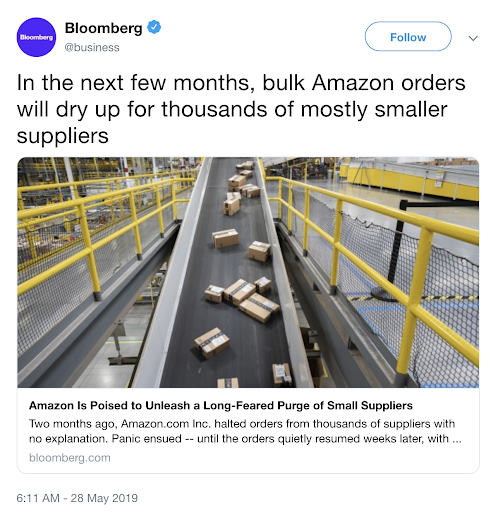Last week, Bloomberg reported anonymous sources at Amazon have confirmed that Vendors will be told to migrate to Amazon’s Seller Central platform in the future. No timeline has been confirmed, but this validates previous Vendor concerns, who were sent an email from Amazon in March, that they will no longer be receiving future purchase orders. Amazon eventually informed all Vendors that the email was sent by mistake, but rumors regarding the future of Vendor Central started gaining traction.
 Link: https://twitter.com/business/status/1133360096040411137
Link: https://twitter.com/business/status/1133360096040411137
So what does this all mean? Vendors were previously selling at wholesale cost to Amazon. Amazon then took control at that point to sell these products on Amazon.com. Vendor Central has been an expensive Amazon operation between upfront capital to purchase inventory in bulk and a large workforce needed to operate Vendor Central.
On the other side, Seller Central, the “Done by Vendor” model, is where brands sell directly on Amazon’s website. Seller Central has been more profitable for Amazon since it does not require a large workforce to operate, nor does Amazon need to input any product capital, and they charge a percentage of every sale through Seller Central.
So why should vendors transition?
More news stories continue to confirm that Amazon will eventually make changes to their Vendor Central program. According to Bloomberg sources, Vendor’s with annual sales under $10M are the highest at risk to be removed from the Vendor program. Also, if your brand’s purchase orders were halted in March, it would be wise to proactively look into moving to Seller Central before Amazon does this again. With the noise surrounding Vendor Central, Vendors should not be reliant on this program’s questionable future.
What are the benefits of Seller Central?
There are four major benefits with selling through Seller Central versus Vendor Central. Those include:
- More control over the customer experience
- Full control over product pricing
- Full control over product inventory placement
- Higher profit margins
Customer experience: Brands want to ensure their customers have a great experience when ordering a product from them. Selling through Seller Central, brands can communicate directly with customers to answer any questions or concerns. Customers also have the ability to contact brands directly. A brand handling customer service inquiries will always be more knowledgeable than relying on a random Amazon support representative.
Pricing: When Vendors sold their product to Amazon in Vendor Central, Amazon controlled the pricing on Amazon.com. Through Seller Central, brands can increase or decrease their pricing at their discretion based off inventory needs.
Inventory: The Vendor Central program is notorious to only purchase the top selling SKUs from a Vendor for obvious reasons. However, in Seller Central, brands can sell their entire product catalog on Amazon.com, which can increase brand exposure and sales volume.
Increase in Profit: On Seller Central, brands can now sell direct to customers at full retail price instead of selling to Amazon at wholesale cost. This will dramatically increase a brand’s profit margin. One will want to be familiar with Amazon’s seller central fees to properly calculate profit margins.
As noted, there are many benefits to use Seller Central instead of Vendor Central that align in the brand’s best interest. If you are currently in the Vendor program, it will be wise to start planning a transition plan to Seller Central to avoid any complications in the future. If you have any questions, feel free to contact our team and we can help you through the transition.
About the Author
Rory McGonigle is the founder and CEO of Smart eStrategy. Smart eStrategy is a digital marketing agency with years of proven results and experience in helping brands boost their sales on their websites and Amazon.


